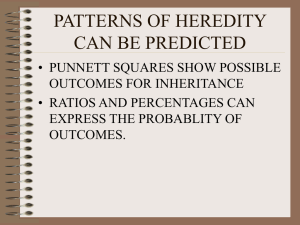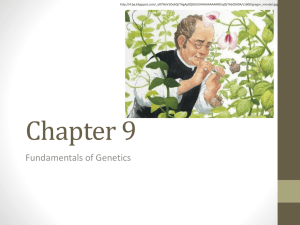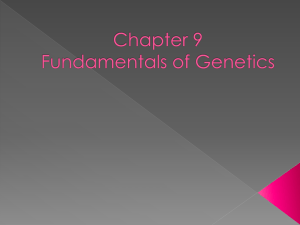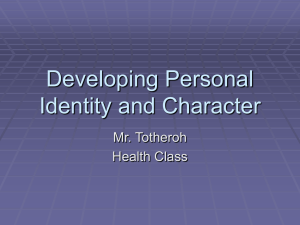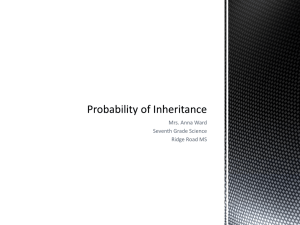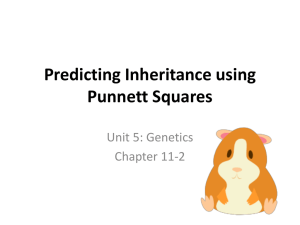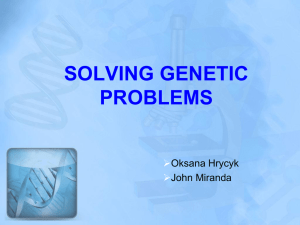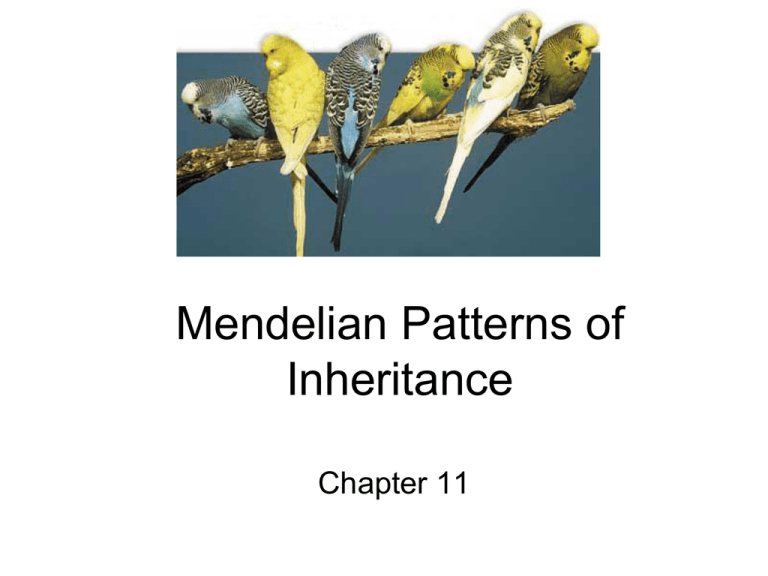
Mendelian Patterns of
Inheritance
Chapter 11
QOD:
c 1. Heredity
i 2. Genotype
e 3. Phenotype
d 4. Dominant
b 5. Recessive
h 6. Alleles
f 7. Homozygous
(Pure)
a 8. Heterozygous
(Hybrid)
g 9. Genetics
Genetics Vocabulary Practice
a. The alleles of a particular gene are
different
b. Not expressed when the dominant
form of the trait is present
c. Passing of trait from parents to
offspring
d. The expressed form of a trait (cover up
other forms)
e. Physical appearance of a trait
f. When the two alleles of a particular
gene are the same
g. Branch of a biology that studies
heredity
h. Different versions of a gene
i. Set of alleles that an individual has
Ch 11
Sexual Reproduction and Genetics
Genetics: the study of heredity
Heredity the passing of traits to the
next generation.
:
(from parent to child)
Trait: a physical feature (blue eyes)
Dominant trait: a trait that always shows,
can cover the other allele.
- represented by a Capital letter
EX: Brown eye: B
Recessive trait: a trait that only shows of
both alleles are present.
- represented by lower case letter
EX: blue eye: b
Codominant: both alleles are expressed
(shown) .
EX: Bb: Brown (B) and Blue (b) eyes are
both expressed
Sexual Reproduction and Genetics
Homozygous: two of the same alleles
Homozygous:
for a particular trait
ex: BB or bb
also called pure
Heterozygous two different alleles for
Heterozygous:
a particular trait
Ex: Bb
also called hybrid
Gregor Mendel: the father of genetics,
studies the traits of pea plants
11.1 Gregor Mendel
“Father of Genetics”
• Developed the fundamental laws of
heredity
• He studied science and mathematics
-chose to study genetics in garden peas (Pisum
sativum)as as they are easily grown and their
pollination is easily controlled. He controlled
pollination by manually moving pollen between
plants Developed True-breeding plants by selfpollination
Funfact: Mendel originally
wanted to breed mice, but
wasn't allowed to because it
was considered scandalous
http://science.howstuffworks.com/life/29784-100-greatestdiscoveries-genetics-and-gregor-mendal-video.htm
Mendel examined varieties of peas for heritable characters
and traits for his study. (stem length, pod shape, seed shape,
seed color..etc)
Developed hybrid plants by crossbreeding two plants of differing characteristics
Tall v Short
Sexual Reproduction and Genetics
Mendel
P generation
parents
F1
offspring 1
kids
F2
offspring 2
grandkids
11.2 Mendel's Law of Segregation
(MONOHYBRID CROSS)
•A monohybrid cross
•
involves one (mono)
character and different
(hybrid) traits.
The F1 seeds were all purple;
the white flower trait failed to
appear at all.
Because the purple flower trait completely masks
the white flower trait when true-breeding plants are
crossed, the purple flower trait is called dominant,
and the white flower trait is called recessive.
Creating the F2
generation
*Cross the F1 generation
together to create F2
*Ratio is always 3:1
Mendel proposed that
the units responsible for
inheritance were discrete
particles - particulate
theory of inheritance
In 1865, Mendel published his
findings in a paper
called Experiments on Plant
Hybridization, which was
mostly ignored at the time due
to a number of reasons. First,
Mendel was not well known in
scientific community. Second,
his theory ran against the
popular model of blended
inheritance.
As Viewed by Modern Genetics
• During production of gametes, only one of the pair
•
•
•
members for a given parent passes to the gamete. (LAW
OF SEGREGATION)
Mendel's units of inheritance are now called genes.
Different forms of a gene are called alleles.
Each allele is given a symbol:
Parental Cross
PP x pp
purple x white
Mendel’s Three Laws
1. Dominance & Recessiveness
2. Segregation: the two alleles for a trait separate (or
segregate) during the formation of gametes
3. Independent Assortment: during gamete formation,
alleles pair independently, meaning a particular allele
for one character can be paired with either allele of
another character
• Two copies of same allele = homozygous. Homo means "the
same"
• Therefore both PP and pp are considered homozygous, just
one is purple and the other is white.
• Some purple-flowered plants could be Pp.
Individuals that
are purple, but had a white parent, are heterozygous: Pp.
Hetero means "different".
The F1 cross
Pp x Pp
purple x purple
Review Terms
F1 vs F2
True Breeding vs Hybrid
Self Pollination vs Cross Pollination
Homozygous vs Heterozygous
Particulate Theory vs Blending Theory
Segregation
The physical appearance of an organism is its phenotype.
Purple-flowered would be a phenotype.
The actual composition of the organism's alleles for a gene is
its genotype: Pp is a genotype.
GENOTYPE
Pp
PHENOTYPE
purple flowers
rr
wrinkled seeds
TT
tall
tt
short
Organisms have many
different genes some
have thousands, and
complex organisms
have 10 times that
number.
BY CONVENTION:
The dominant trait is given a capitol letter, the lowercase of that
same letter is the recessive trait. DO NOT MIX LETTERS. Pick
one and stick to it.
Also, some letters are better than others. Capital S looks a lot
like a lowercase (s). Pick a different letter...
Okay
Short hair = SS
Short hair = Ss
Long hair = ss
Steps to solving genetics problems
1. Key
2. Parents cross
3. Punnett Square
4. Genotype and ratio
5. Phenotype and ratio
Better (use H for hair)
HH
Hh
hh
Punnett Square: to predict outcome of offspring
Steps to solving genetics
problems
Cross heterozygous green pea
1. Key
(Gg) with heterozygous green pea 2. Parents cross
3. Punnett Square
plant (Gg). Yellow is recessive.
4. Genotype and ratio
5. Phenotype and ratio
P = Gg x Gg
G
g
G
GG Gg
g
Gg gg
F1
Key: GG: Gg:
green
gg
yellow
Genotype: ¼ GG; 2/4 Gg; ¼ gg
Genotype ratio: 1:2:1
Phenotype: ¾ green; ¼ yellow
Phenotype ratio: 3:1
In dragons...
Wings are a dominant
trait, but some dragons
are born wingless.
1. If a wingless dragon is
crossed with one that is
heterozygous, how many
of its offspring will also be
wingless?
2. What are the chances that
two heterozygous dragons
have a whelp that is wingless?
If a wingless dragon is crossed with one that
is heterozygous, how many of its offspring will
also be wingless?
P = ff x Ff
f
f
F
Ff
Ff
f
ff
ff
F1
Key: FF: Ff:
wings
ff
wingless
Genotype: 2/4= ½ Ff; ½ ff
Genotype ratio: 1:1
Phenotype: ½ wing; ½ wingless
Phenotype ratio: 1:1
What is a test cross?
Help, help! I don't know
what my genotype is!!
Am I Ff or FF?
Key:
F= winged
f=wingless
I can help
you! Let's
have offspring!
Practice with Punnett Squares
1. A round seeded plant (RR) is crossed with a wrinkle
seeded plant (rr). What are the phenotypes of the offspring?
2. Two heterozygous purple flowered pea plants are
crossed. What are the phenotypes of their offspring and in
what proportion?
3. A plant with green seeds (yy) is crossed with a
heterozygous plant. What percentage of their offspring have
yellow seeds?
Why does the punnett square work?
It all goes back to meiosis.. each side represents a sperm or
egg. The boxes filled out simply give you the statistical chance
that a certain sperm will fertilize a certain egg.
Probability: The chance that an event will occur
- It is a prediction, and it could be wrong.
Mendel’s Laws of Probability
-
Can use probability and math to solve genetic problems.
Ex: If two parents are heterozygous for nostril flaring.
P= Ee X Ee
Chance of E =½
Chance of e = ½
1.
2.
3.
4.
Chance of EE = ½ x ½
Chance of Ee = ½ x ½
Chance of eE = ½ x ½
Chance of ee = ½ x ½
=¼
=¼
=¼
=¼
Ee= ¼ + ¼ = ½
If a wingless dragon is crossed with one that is
heterozygous, how many of its offspring will also be
wingless?
P = ff x Ff
½½
Key: FF: Ff:
wings
½½
1
fF= 1 X ½ = ½
ff=1 x ½ = 1/2
ff
wingless
Incomplete Dominance
Incomplete
Dominance
Traits appear to
"blend" in offspring
RR x WW
RW (pink)
Show:
Pink x Red
Pink x Pink
White x White
Figure 11.14
This illustrates
another style of
"letters" to denote
genotypes
R1 and R2
Coloration in Rodents
Black x White = Gray
BB x WW = BW
Sickle Cell Trait in Humans
Genotypes & Phenotypes
Pleiotropic Effect: a single mutant gene affects two or
more seemingly unrelated traits
- Sickle cell shape, and resistant to malaria parasite
Prevalence of Malaria
In tropical Africa, where
malaria is common:
homozygous dominant
individuals die of malaria
homozygous recessive
individuals die of sickle cell
anemia
heterozygote carriers are
relatively free of both
reproductive advantage
Pleiotropic Effect: a single mutant gene
affects two or more seemingly unrelated
Prevalence of
Sickle
Cell Anemia
Codominance
ROAN COW What happens when you cross a white and a red cow?
Roan is codominant - both alleles R and W are expressed
What happens when two Roan Cows
are Crossed?
R
R
RR
r
Rr
r
Rr
rr
In Make believe flowers…….
Incomplete Dominance
Key: RR = red
Rr = purple (BLENDING)
rr = blue
CoDominance
Key: RR = red
Rr = red and blue (both are expressed)
rr = blue
Ex: A brown bird crosses with a white
one and all the offspring produced are Key: BB= Brown
tan. If these offspring were crossed
Bb = Tan
and produced 16 birds, how many
bb = White
would be tan?
P = Bb x Bb
B
b
Genotype: ¼ BB; ½ Bb; ¼ bb
B
BB Bb
Genotype ratio: 1:2:1
b
Bb
Phenotype: ¼ Brown ; ½ Tan ; ¼ White
bb
F2
Phenotype ratio: 1:2:1
If these offspring produced 16 birds how many would be expected
to be tan? 8
QOD:
1. What does INDEPENDENT ASSORTMENT mean?
In your own words, describe what it means with
regard to Mendelian genetics.
2. Mendel would have never developed this law if
he'd chosen traits located on the same
chromosome. Why do you think that would have
altered his results?
Dihybrid Cross
Mendel's Law of Independent Assortment –
Illustrated by the DIHYBRID cross
law describes the outcome of dihybrid (two
character) crosses, or hybrid crosses involving
additional characters.
A dihybrid is an individual that is a double
heterozygote (e.g., with the genotype RrYy - round
seed, yellow seed).
What are the gametes that can be produced by this
individual?
Dihybrid Cross: RrYy x RrYy
cross two traits at same time: remember independent assortment
1a.
Key:
In pigs,
T = curly tail
t = straight tail
Complete dominance
P = TtBb
B =brown coat
b = white coat
Complete dominance
x
G TB, Tb , tB, tb
X
TtBb
TB, Tb, tB, tb
Phenotype
Genotype:
TB,
Tb ,
tB,
1/16 TTBB
tb
9/16 curly tail & brown coat
2/16 TTBb
TB TTBB
TTBb
TtBB
TtBb
2/16 TtBB
3/16 curly tail & white coat
4/16 TtBb
Tb TTBb
TTbb
TtBb
Ttbb
tB
TtBb
ttBB
ttBb
TtBB
1/16 TTbb
3/16 straight tail & brown coat
2/16 Ttbb
1/16 straight tail & white coat
1/16 ttBB
tb
TtBb
Ttbb
ttBb
ttbb
2/16 ttBb
1/16 ttbb
Pheno ratio: 9 : 3 : 3 : 1
1a.
Continued….
What percentage of the offspring will be purebred
dominant for both traits? 1/16 or 6%
What percentage of the offspring will be hybrid for
both traits?
4/16 or 25%
Genotype:
Phenotype
1/16 TTBB
Key:
In pigs,
T = curly tail
B =brown coat
2/16 TTBb
t = straight tail
b = white coat
1/16 TTbb
9/16 curly & brown
2/16 TtBB
4/16 TtBb
3/16 curly & white
2/16 Ttbb
1/16 ttBB
3/16 straight & brown
2/16 ttBb
1/16 ttbb
1/16 straight & white
All of these type of crosses will follow the same ratio
AaBb x AaBb both heterozygous for both traits
9 - (two dominant traits)
3 - (one dominant, one recessive)
3 - (one recessive, one dominant)
1 - (two recessive traits)
1b.
Key:
In pigs,
T = curly tail
t = straight tail
Complete dominance
P = TTbb
G
Tb
x
X
B =brown coat
b = white coat
Complete dominance
ttbb
tb
Phenotype
Tb
Genotype:
100% Ttbb
tb
Ttbb
Pheno ratio: 0 : 1 : 0 : 0
100% curly tail and white coat
3.
Key:
In Drosophila fruit flies
W = long wings
w = vestigial wings
Complete dominance
P = Wwhh
Wh, wh
G
Wh
WH
wh
WWHh WwHh
Wh
WWhh
Wwhh
H = hairless body
h = hairy body
Complete dominance
x
WWHh
X
WH, Wh
Genotype:
Phenotype
1/4 WWHh
50% long wings and hairless body
1/4WwHh
50% long wings and hairy body
1/4 WWhh
1/4 Wwhh
Pheno ratio: 1 : 1 : 0 : 0
What percentage of the offspring will have long wings and hairless bodies?
50%
2.
Key:
In pea plants
L = long stems
l = short stems
Complete dominance
P = LLgg
G
Lg
x
X
G =green pods
g = yellow pods
Complete dominance
llGG
lG
Lg
lG
LlGg
Genotype:
Phenotype:
100% LlGg
100% long stems and green pods
Pheno ratio: 1 : 0 : 0 : 0
It may be faster to solve problems mathematically.
This one is NOT 9:3:3:1
HhBb x hhBb
How many off the offspring will be short haired and red
eyed?
Try another mathematical model..
Winged, Fire breathing dragon DdFf
x
Wingless, Fire breathing dragon ddFf
Consider the cross between a plant with round seeds, purple
flowers to one with wrinkled seeds and white flowers ...
RrPp x rrpp
Multiple Alleles
Multiple Alleles: more than two alleles in the population
ex: Blood Types
Blood Type
There are 3 alleles that code for what type of blood you
have. A, B, and O. A and B are Co-Dominant and O is
recessive.
Phenotype Genotype
Type A
IAIA, IAiO
Blood Donor
Donate to Type A/AB
% of population
42%
Type B
IBIB, IBiO
Donate to Type B/AB
Type AB
IAIB
Universal recipient/Donate to AB
4%
Type O
iO iO
Universal Donor/ only receive O
44%
10%
Practice #1
Cross: Type A (AA) father with a type 0 mother. What
are the possible blood types of the offspring?
P = AA x OO
A
A
O AO AO
O AO
AO
Genotype: 4/4 AO
Phenotype: 4/4 Type A
Practice #3
Suppose two newborn babies were accidentally mixed up in a
hospital, something that rarely happens. In an effort to determine
the parents of each baby, the blood types of the parents and the
babies were determined.
Baby 1-type B
Mrs. Davisson-type B Mrs. Morgan - type O
Baby 2-type O
Mr. Davisson- type B Mr. Morgan - type AB
A
Name
Genotype
Mrs. D
BO
Mr. D
Mrs. M
Mr. M
Baby 1
Baby 2
BB, BO
BO BB, BO
OO OO
AB AB
BO BB, BO
OO OO
B
O AO BO
O AO
BO
1. Which baby belongs to Mr. &
Mrs. Davisson?
Baby 2
2. Which baby belongs to Mr. and
Mrs. Morgan? Baby 1
Chapter 9
blood type is located on chromosome #9
• Type A, B, AB or O
RH factor is a separate gene that codes for
another protein. This is the positive or negative
part of the blood type, on chromosome #1.
Many Genes Have Multiple Alleles
A population might have more than two alleles for a given gene.
In Labrador retriever, coat color is determined by one gene with four
different alleles. Five different colors result from the combinations of these
alleles. (More on labradors later)
•
•
Eye color is also controlled by multiple alleles
The simulation is a bit simplified, but the idea is that MULTIPLE
ALLELES control a single trait (eye color)
It is likely that more than 2 alleles
control eye color, this is simplified just
made it simple to understand.
Polygenic Traits
• Individual heritable characters found to be controlled by groups of
several genes, called polygenes.
• Each allele intensifies or diminishes the phenotype.
• Variation is continuous or quantitative (adding up) - also called
quantitative inheritance
• Seed Color in wheat - aabbcc, Aabbcc, AaBbcc, AaBbCc, AABbCc,
AABBCC (light, intermediate colors, dark)
• In humans - hair color, height, skin color
Pg 197
Polygenic Inheritance
AABBCC x aabbcc (P)
AaBbCc x AaBbCc (F1)
Seven Possible Phenotypes in the F2
The more “dominant” alleles for dark pigmentation (caused by melanin), the darker the skin
Figure 11.16
Environment and Phenotype
Temperature, water, food sources can have an affect on how a gene is
expressed = “multifactoral”
Rabbits have a gene that codes for darker
pigments - this gene is more active at low
temperatures. Parts of the body that are
colder will develop the darker pigmentation ears and feet
•SIAMESE CATS
Multiple Alleles control the combs of
chickens.
Assignment:
Multiple Alleles in
Chickens
LEGHORN
CHICKEN –
SINGLE COMB
BUTTERCUP CHICKEN - BUTTERCUP COMB
Buckeye Chicken – Pea Comb
Wyandotte Chicken - Rose Comb
Lethal Genes (Not in book, added)
• Some genes are lethal when both
•
•
alleles are present. Lethality can
occur before or after birth
Huntington's disease in humans is
caused by a lethal allele, death
occurs later in life
Other examples: Mouse coat color
(yellow), Creeper legs in chickens,
Manx Cats (no tails)
An example is the "creeper" allele in
chickens, which causes the legs to be
short and stunted.
Manx cat
X- linked traits
Complex
Inheritance
and
Human
Heredity
X-linked traits: traits on the X chromosome
• Colorblindness
• Hemophilia
• Muscular Dystrophy
More common in males
Colorblindness
sex-linked recessive condition in which
people can’t see certain colors
don’t make some of the pigments in the eye
that are necessary for color vision.
The most common form is red-green colorblindness
Normal color vision : 29
Red green color blind : a bunch of spots!
Normal color vision : 56
Red green color blind : 56
Normal color vision : 8
Red green color blind : spots
Hemophilia: condition that impairs the blood’s
ability to clot.
Hemophilia is a recessive sex-linked trait.
Also known as bleeders
disease
Hemophilia: Royal Disease
Muscular Dystrophy (MD): disease that results in
progressive wasting away of skeletal muscle.
Caused by a defective protein known as
dystrophin
Ex:
Colorblindness
Key:
XX = female normal vision
XXe = female carrier
(normal vision)
XeXe = female colorblind
XY = male normal
vision
XeY = male colorblind
Cross carrier female
with normal male
P = XY x X Xe
X
X
XX
Xe XXe
Y
XY
XeY
Genotype
Phenotype
1/4XX:
female normal vision
1/4 XXe :
female carrier
1/4 XY:
male normal vision
¼ XeY:
male color blind
What % of their boys will be expected to be colorblind?
50%
Hemophilia
Key:
XX = normal female
XY = male normal
XXh = female carrier
XhY = male hemphiliac
XhXh = female hemophiliac
MD
Key:
XX = normal female
XXm = female carrier
XmXm = female with MD
XY = male normal
XmY = male with MD
Carrier
1. XY male normal
2, XXe female carrier
3. XY male normal
4. XXe female carrier
5. XXe female carrier
6, XY male normal
7. XeY male colorblind
8. XXe female carrier
9. XX or XXe
10. XeY male colorblind
11. XY male normal
12. XeXe female colorblind
Complex Inheritance and Human Heredity
Pedigrees:
A diagram that traces the inheritance of
a particular trait through several
generations
Human Disorders
Pg 192
Autosomal Recessive vs Autosomal Dominance
Aa
Aa
aa
Aa
Aa
aa
Figure 11.10
Figure 11.11
Hereditary Genetic Disorders
Name of
Disorder
Tay Sacks
Cystic Fibrosis
PKU
Sickle Cell
Disease
Neurofibromatosis
Huntington's
Disease
Huntington's
Disease
Type (autosomal,
sex linked,
dominant,
recessive)
Description/
Symptoms
Type of people
group/ treatment /
other
Tay Sachs
Autosomal recessive
-progressive deterioration of nerve cells and of mental and
physical abilities
Young children begin showing signs of slowed development
Severe impairment and death
strikes 1 in 3600 births
100 times greater than incidence
among non-Jews
non-functional enzyme fails to
breakdown lipids in brain cells
fats collect in cells destroying their function
symptoms begin few months
after birth
seizures, blindness &
degeneration of muscle &
mental performance
child usually dies before 5yo
Cystic Fibrosis
autosomal recessive
-More common in
Caucasians
-Mucus in
respiratory tract,
difficulty breathing
extreme salty sweat
-Mucus may cause
secondary infections
http://www.redorbit.com/news/video/health_2/1113011363/miracle-drug-for-cystic-fibrosis-11222013/
Effect on Lungs
normal lungs
airway
Cl–
Chloride channel
transports salt through
protein channel out of cell
Osmosis: H2O follows Cl–
Cl– channel
H 2O
cells lining lungs
cystic fibrosis
Cl–
bacteria & mucus build
up
H 2O
thickened mucus
hard to secrete
mucus secreting glands
Phenylketonuria (PKU)
• Lack enzyme for normal
metabolism
• Phenylalanine builds up and
causes brain damage
• Newborns are routinely
tested
• Changes in diet lead to
normal life
Phenylalanine Hydroxylase is
the enzyme needed, absent in
those with PKU
http://www.youtube.com/watch?v=XKSoMi4U
-1k
http://www.youtube.com/watch?v=w3L2SPj7a
lQ
autosomal recessive
Sickle Cell Disease
• More common in Africans
(African-Americans)
• Causes blood to be sickle
shaped
• Affects oxygen flow to
•
organs, causing
weakness, pain, anemia,
etc
Heterozygotes are
resistant to malaria
AA = normal
Aa = sickle cell trait
aa = sickle cell disease
Neurofibromatosis
-Autosomal dominate
-carry high risk of tumor
formation
-Tumors form under skin
and can cause skeletal
deformities, blindness
"The Elephant Man"
Several years ago, research teams located the exact
position of the NF1 gene on chromosome 17. The
product of the NF1 gene is a large and complex protein
called neurofibromin, which is primarily active in nervous
cells as a regulator of cell division. Intensive efforts have
let to the identification of the NF2 gene on chromosome
22. The NF2 gene product is a tumor-suppressor protein
called merlin.
http://www.bcnf.bc.ca/learn/about-the-charity/
Huntington's Disease
HH = Huntington's
Hh = Huntingtons
hh = normal
Symptoms appear later in
life, often starting with
poor muscle control
Autosomal Dominant
neurodegenerative genetic
disorder that affects muscle
coordination and leads to
cognitive decline
There are different types of dwarfism.
Achondroplasia is caused by a dominant allele.
Meet Kenadie
http://www.youtube.com/watch?feature=player_em
bedded&v=_QBy8DFaLR4
Two dwarfs can have a
normal child. Dd x Dd
Primordial
Dwarfism

